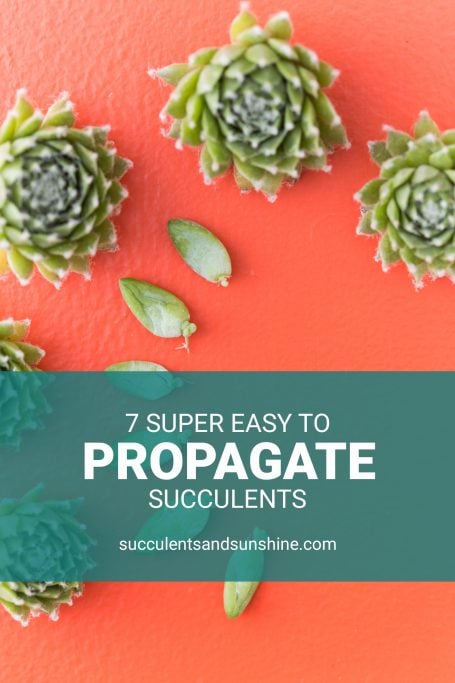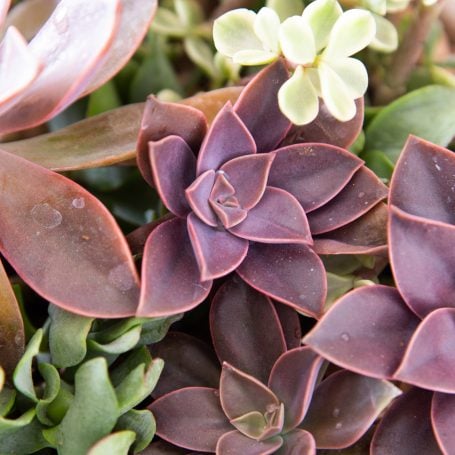When you buy something from this site, we may receive a commission for it, but this won’t cost you any extra. This helps us to create free content for you to enjoy.
Many succulents can be propagated through cuttings and leaves, while some varieties can produce new growth on their own.
If you are a beginner in propagating succulents, it may be challenging to determine which types of succulents are best propagated through leaves, cuttings, or self-propagation.
Yes, that’s why I’m here! I am eager to learn about succulents that are easy to propagate. Please do tell me about these seven succulents.
Beware: if you start growing succulents, you may become hooked! I certainly did when I started out; I wanted to have more, but couldn’t afford it.
I found out about propagation when I started looking for plants to add to my collection. I’m sure you’ll really enjoy the ones I’ve found because they are great for growing and expanding your garden. Let’s get started!
This plant is considered to be an invasive weed in many places because of its ability to spread rapidly. I attempted to purchase one from a seller in Florida while I was writing a book on succulents, but he refused, as he was adamant about how bad this plant was.
I’m quite taken with this plant! Its leaves are lined with miniature replicas of itself, which drop off and take root when they are ready to start their own life cycle.
It is such a delight to observe the edges of these leaves teeming with fresh young leaves!
Table of Contents
Sedum morganianum | Burro’s Tail
I love propagating this type of succulent from its leaves. It is so resilient and will also thrive when propagated from cuttings. It is a real survivor.
I adore the ability to use this plant as a trailing plant in arrangements. It’s quite common to find these specimens growing quite long in areas where they are not disturbed.
Sedum rubrotinctum | Jelly Bean Succulent
Ahhh, the Sedum rubrotinctum. Don’t you just want to squish it? This type of succulent is very similar to the Sedum morganianum, but it has more vibrant colors and is just as abundant.
The foliage of this plant is prone to dropping off, but don’t be concerned! Those leaves will soon form a new plant.
You can propagate this plant by taking cuttings and replanting them in another location, or pass them on to someone else. It’s a generous plant!
Graptoveria ‘Fred Ives’
My sister-in-law had an overgrown Fred Ives plant that was becoming unappealing. We trimmed the top of the plant and transplanted into a new pot. The stem was kept, which ended up sprouting new shoots. I chose to keep the stem and observe its progress, which resulted in even more new growth.
That dude is really incredible!
Graptopetalum paraguayense | Ghost Plant
This succulent grows quickly compared to other varieties. Although it’s not ideal for growing indoors, it will thrive in a sunny outdoor area for a long time.
It is simple to spread from leaves and cuttings, leading to the development of beautiful small rosettes.
Graptosedum ‘California Sunset’
This plant is just as easy to propagate from leaves and cuttings as its rosette-forming companions above. It quickly grows into clumps of attractive rosettes as it matures.
You may be delighted to find that each leaf you propagate yields 2-3 rosettes, a special bonus for you!
It takes a lot of sunlight for the deep red hue to stay vibrant, so when it’s mature, it’s best to place it somewhere that receives direct sunlight throughout the day.
Sempervivum varieties
If you reside in a place that experiences snow and freezing temperatures during the wintertime, you will absolutely love this succulent. The Sempervivum arachnoideum, commonly known as houseleeks or hens and chicks, is featured in the image above.
These succulents can withstand the cold winter months with ice and snow. When springtime comes around, they will begin to reproduce rapidly, with numerous offspring being produced by the end of summer. You may find yourself with an abundance of them, not knowing what to do with them all.
These would be an excellent choice for both container gardening and ground cover.
I consulted with my succulent-loving buddies and compiled a sizable list of impressive succulents that produce copious amounts of offspring. These are just seven of the many successful propagators in the group.
Here are a few popular succulent plants: Echeveria imbricata, Aloe vera, Cremnosedum ‘Little Gem’, Graptoveria ‘Alpen Glow’, Portulaca molokiniensis, Mammillaria elongata, “String of Pearls”, Kalanchoe tomentosa, Mammillaria gracilis fragilis, Kalanchoe ‘Aurora Borealis’, Kalanchoe marmota, Aloe nobilis, and Senecio mandraliscae.
You should get some new plants to propagate and then keep up with the progress of them each week. I post updates on the plants I’m propagating here.
FAQ
Which succulents propagate the fastest?
Alternative: – Crassula. This well-known type of succulent is a favorite amongst novice gardeners because of its quick growth—it can reach heights of up to 18 inches in just one year! …
– Kalanchoe. …
– Aeonium. …
– Aloe. …
– Sedum. …
– Haworthia. …
– Graptopetalum. …
– Echeveria.
What are the hardest succulents to propagate?
Leaf propagation isn’t the best solution for all succulents; Aeonium and Sempervivum don’t respond well, however Sedum and Echeveria with their plump leaves can have more success.
What succulents Cannot be propagated?
Leaf propagation is not suitable for all succulents; Aeonium and Sempervivum do not respond positively to this process. On the other hand, succulents with plump leaves such as Sedum and Echeveria have a higher chance of success with leaf propagation.
What is the fastest succulent to propagate?
…
Re-phrase:
– Echeveria ‘Purple Pearl’ …
– Sedum rubrotinctum, otherwise known as Pork and Beans or Jelly Beans …
– Echeveria ‘Lola’ …
– Sedum nussbaumerianum …
– Sempervivum arachnoideum, which is commonly referred to as the Cobweb Houseleek …
– xGraptoveria ‘Debbie’ …
– Graptopetalum paraguayense, otherwise known as the Ghost Plant …
– Sedum morganianum ‘Burrito’ …
Can all succulents be propagated in water?
It is possible to propagate succulents in water, but it is not recommended since it does not provide the necessary growing conditions that these plants require. For best results, it is recommended to start propagating the leaves and cuttings in shallow planting trays or small containers filled with potting soil.


